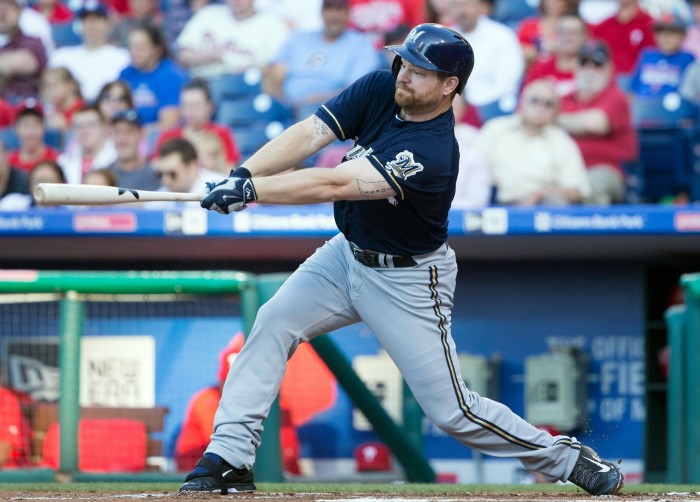On Wednesday, the Milwaukee Brewers traded Adam Lind to Seattle for a trio of teenage pitchers who have yet to pitch in full-season ball in the minors and are not ranked in the Mariners’ top-30 prospects by MLB.com. It’s the sort of deal that elicits sighs and groans from the Milwaukee faithful, rather than fist pumps and celebrations. It’s the sort of deal that lends itself to the “Brewers Trade [Known Player] For Prospects” narrative that small-market fans abhor, the narrative that drives away casual fans.
With that being said, new general manager David Stearns didn’t necessarily negotiate a poor return for a player who hit .277/.360/.460 in 2015 with 20 homers. The trade is just more difficult to understand because the assets in question are unknown quantities. Hell, even many within the scouting community have never heard of these players or have never seen them in person. As such, the long-term gain is too abstract to evaluate with any sense of certainty.
The Brewers obviously like the three pitchers they received in the deal. Right-hander Carlos Herrera (who just turned 18) spent last season in the Dominican Summer League, posting a 3.26 ERA with a solid strikeout-to-walk ratio (5.62 K/BB). He throws in the high-80s and low-90s with some projectability. A couple scouts told me that he’s the real prize in this deal, even if he’s a bit of a mystery. Daniel Missaki is another right-handed hurler (only 19 years old) who is best known for his time with the Brazilian national team. He’s currently rehabbing from Tommy John surgery, but reportedly has good feel for multiple pitches. Finally, Freddy Peralta (also 19) popped up on the prospect radar in 2014 when his velocity ticked upward into the mid-90s. The heater regressed this past season, though, and his 4.11 ERA won’t capture one’s attention. Still, the 8.38 strikeout-to-walk ratio is tremendous and eases some of the concern about his ugly run prevention.
David Stearns told Tom Haudricourt of the Milwaukee Journal Sentinel, “Whenever you acquire players that are farther away, there is more variance….So, in a deal like this, we’re really targeting that variability to find an impact-type pitcher, even if it’s multiple years down the road.” This means that Herrera, Missaki or Peralta could flame out before Double-A or they could become useful Major League arms. And given the fact that we’re perhaps talking about another three-to-five years until the muddled picture becomes somewhat clear, this trade cannot possibly resonate with the vast majority of Brewers fans. It requires patience with absolutely no guarantee of any return on that investment.
That’s why the Adam Lind trade is best understood through its process, what acquiring three no-name teenagers can tell us about David Stearns and his overall strategy for the club.
It appears that Stearns is carrying over a key piece of the Houston Astros’ rebuilding playbook, in which a club cannot be afraid of targeting extremely young pitchers in the low minors — especially in return for non-elite Major League assets. The Astros, for example, got David Paulino for Jose Veras and Francis Martes as the “throw-in” in the Jarred Cosart deal. Both of those formerly no-name prospects are now two of the hottest prospects in the Astros’ farm system. It’s a conscious approach that Evan Drellich of the Houston Chronicle profiled in September. This Lind trade is an example of David Stearns trusting his scouting department, trying to bring unknown prospects into the Brewers’ system before they have a chance to mature and have a breakout season. Because after that hypothetical breakout, the Brewers would no longer be able to afford the asking price. The ultimate buy-low strategy, if you will.
Of course, this type of strategy puts a premium on scouting and player evaluation. They have to get it right enough to make it worthwhile. Fortunately, recent success in drafts leads one to believe that the Brewers’ scouting department has quality members who are capable of getting the job done well. Ray Montgomery and his staff have been aces over the past couple years.
All of this doesn’t mean Stearns and the Brewers will consistently eschew big-league players or guys in the upper minors. This simply indicates that the Brewers will not rely on Doug Melvin’s strategy of targeting players who have already found success in the Double-A level or above. Stearns already has seen this type of strategy work in Houston and appears to be transitioning it over to Milwaukee.
It is also important to recognize that quantity should not be ignored during a rebuilding process. The Milwaukee Brewers must stuff the farm system with as much talent as possible and across the minor-league spectrum. This isn’t just to spread out one’s hypothetical competitive window, nor is it some kind of “throw dozens of prospects at the wall and see who sticks” argument. Instead, I’m acknowledging the fact that Milwaukee needs excess minor-league talent. It’s not enough to have the next core of homegrown players in the minors. An organization must also have the depth necessary to trade for more Major League players. Just as the Chicago Cubs, Houston Astros, and Toronto Blue Jays are all beginning to flex their prospect muscles to maximize their windows of contention (which are of varying sizes), the Milwaukee Brewers must have the prospect depth to both develop a core and supplement it.
In the end, this Adam Lind deal should be understood as an attempt to acquire quantity and quality. The latter is more abstract and won’t pay dividends for perhaps a half-decade, but it is clearly a conscious attempt at acquiring high-end prospects — just a year or two before they become high-end prospects. This is just more evidence that David Stearns and his staff are willing to be creative and patient, a highly desirable combination during a full-scale rebuilding process. Brewers fans should be happy, regardless of how the three young pitchers turn out.

3 comments on “Stearns Shows His Houston Roots In Trading Adam Lind”